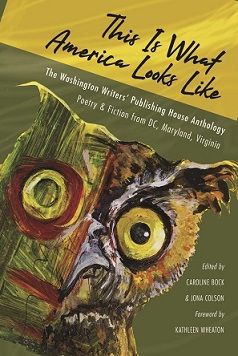A new regional anthology seeks to answer that question!

Can we agree on one thing? Time has slowed, dragged her slipper-worn feet, binged too many Netflix series, and attended too many virtual meetings where the connection wonks out.
Time, and we, have been on hold this past year.
What do writers do with time — and, more specifically, make of this moment in time? I was pondering that question even before the covid-19 crisis hit as I watched the wide-open, joyous way thousands of us marched down Constitution Avenue at the Women’s March in 2018.
“What does America look like?” rose our chant. “THIS is what America looks like!”
But what does that mean?
I began mulling over the idea of asking writers to share what America looks like to them and, in late 2019, took the idea to my colleagues at the nonprofit, all-volunteer Washington Writers’ Publishing House (WWPH).
“Would we be interested in publishing an anthology?” I asked the group of a dozen or so fellow writers.
“We haven’t done one in 25 years,” they responded. “Maybe it’s time.”
I am forever grateful that Jona Colson, winner of the WWPH’s 2018 Jean Feldman Award for poetry, asked, “Is there space for poetry?” There is always space for poetry at the WWPH, which was founded in 1973 as a poetry publisher by Grace Cavalieri and others. Jona volunteered to be the anthology’s poetry editor, and we were on our way.
Last February, we put out the call for submissions for This Is What America Looks Like: Poetry & Fiction from DC, Maryland, Virginia. Then the pandemic hit.
Submissions tumbled in — and then flooded us. I read every fiction entry with Kathleen Wheaton, our astute, longtime publisher and president, as spring turned slowly to summer.
What did I learn? That America is the pandemic, but it is also racial injustice. It is undocumented immigrants, domestic violence, and the murderous frustration of working for minimum wage at Waffle House.
It is death in Black and in white families. It occasionally looks like love.
Among other things, America is the Depression-era coal-mining family in Mary Kay Zuravleff’s “Myrna, 1934.” It is M.M. Bailey’s “Smaller,” about acts of violence committed during the pandemic. It’s Adam Schwartz’s “Brothers,” about siblings trying to make amends, and Melanie S. Hatter’s story of abuse, “Angel in Pink.” Leslie Pietrzyk captures America via a simmering moment on Pennsylvania Avenue in “Admit This To No One,” while Len Kruger depicts it in his flash-of-rage tale, “I’m Not Sorry.”
It is all these stories and so much more.
When it came to making this anthology a reality, time — thanks to covid-related delays and the general vagaries of the industry — wasn’t on our side, but we managed to achieve our target publication date of Feb. 2, 2021.
I hope the collection helps us all make sense of this moment we’re living in, lends it some beauty, and offers a revelation or two.
[Editor’s note: The Writer’s Center in Bethesda, MD, will host the inaugural reading for This Is What America Looks Like on Fri., Feb. 5th, at 7 p.m. (EST). Click here for info.]
Caroline Bock is the fiction editor of This Is What America Looks Like: Poetry & Fiction from DC, Maryland, Virginia and the author, most recently, of Carry Her Home.

